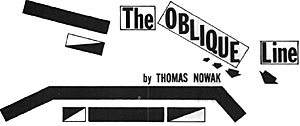 The oblique line was one of the most startlingly successful yet least employed of all pre-modern battle tactics. Its history, which ranges from ancient to Napoleonic times,
offers us not only an interesting glimpse of warfare through
the ages butalso a chance to consider the tactic's application to gaming itself. But before we see if the Theban general Epaminondas, the accredited originator of this tactic,
does tie us into any boardgames, we must first stop at the
history books. There the spectacular but brief course of the
oblique line's evolution, its final definition and later refinement will reveal itself.
The oblique line was one of the most startlingly successful yet least employed of all pre-modern battle tactics. Its history, which ranges from ancient to Napoleonic times,
offers us not only an interesting glimpse of warfare through
the ages butalso a chance to consider the tactic's application to gaming itself. But before we see if the Theban general Epaminondas, the accredited originator of this tactic,
does tie us into any boardgames, we must first stop at the
history books. There the spectacular but brief course of the
oblique line's evolution, its final definition and later refinement will reveal itself.
Our earliest reference to the origin of the oblique line was recorded by the Greek historian, philosopher and one-time general, Xenophon (434 to 355 B.C.). In his work the Cyropaedia he recounted a battle between the armies of Cyrus the Great (Persia) and King Croesus of Lydia (Assyria).
This encounter in either 545 or 546 B.C., before the fall of Sardis and Croesus' kingdom was probably more imagined than real on the part of Xenophon. In other words there is serious doubt whether the so-called battle of Thymbra. ever occurred! The story is, however, worth repeating. Xenophon weaves a tale of how Cyrus, outnumbered about two to one, advanced with a narrow battle line, backed by four reserve lines. This in itself was a departure from the standard one-big-line type of formation.
Croesus was not to be outdone. He too came up with something new. As Xenophon wrote, to keep his flanks "from coming in contact with the enemy before the centre was ready to attack, "Croesus drew them in or inclined them away from his main line. But this was only a temporary ploy. Having the superior numbers, Croesus wheeled his wings out and around against both of Cyrus' flanks.
Cyrus easily met this threat with reserves from the rear, but this was no guarantee for his survival. Then 'a roll of the die' went in his favor. Noticing a gap between the left wing and the centre of Croesus' line, an amazed Cyrus exclaimed, "I wonder at it for to me they seem to draw off their wings very far from their line." He acted quickly. Into this hole he sent his best troops, thereby threatening the rear of Croesus' line. With this the King of Lydia was forced to withdraw.
Without his much-needed victory, Croesus pulled back into Lydia, technically a beaten man, as his kingdom would fall to Cyrus' advancing army some time later. At this point we can only conclude that while the concept of an oblique line was lacking, attention had been focused upon the disengaged flank. A step towards definition had been taken.
More Oblique Line
Back to Table of Contents -- Panzerfaust #56
To Panzerfaust/Campaign List of Issues
To MagWeb Master Magazine List
© Copyright 1972 by Donald S. Lowry.
This article appears in MagWeb (Magazine Web) on the Internet World Wide Web.
Other military history articles and gaming articles are available at http://www.magweb.com